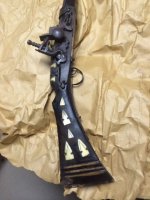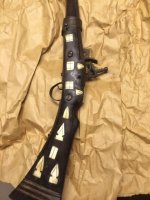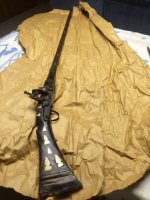You are using an out of date browser. It may not display this or other websites correctly.
You should upgrade or use an alternative browser.
You should upgrade or use an alternative browser.
Origin of this one?
- Thread starter wreace
- Start date
RJay is correct. Unlike many previous wars, American GI's are prohibited from bringing home "war trophies" captured from the enemy, since most of those are automatic weapons. So the "boys in the bazaar" have been turning out souvenirs, handguns and rifles/muskets, by the thousands to unload on the GI's as real, honest to gosh, antique, valuable, old time, flintlocks, and legal to take or ship home. Guaranteed worth thousands of dollars, sah, guaranteed! See mark right there says 14th century, sah!
Jim
Jim
Thanks for all the replies.
Here are some answers. The musket looked old when my grandfather first showed it to me 65 years ago. I don't know if it was ever fired, but the mechanism all worked back then -- it could be cocked and released.
While I thought it might be from the family (we did have ancestors who fought in the Revolution), it also could be from somewhere else. My grandparents took a number of trips to Europe and Asia.
The inlays are real -- I can see some areas where the wood was cut out to imbed the inlay. I don't know what the stone is, but it fits smoothly in the wood.
Sometime before I got it some repair work was done -- some of the wood below the mechanism was replaced, and some of the large screws look like out of place.
It stands about 57 3/4 inches tall, and the barrel is about 1/2 " wide -- smaller than most muskets of the 1770s, I understand.
No place for a bayonet -- and those were used during the Revolutionary war, I understand, so that makes me wonder.
Any other questions?
wreace
Here are some answers. The musket looked old when my grandfather first showed it to me 65 years ago. I don't know if it was ever fired, but the mechanism all worked back then -- it could be cocked and released.
While I thought it might be from the family (we did have ancestors who fought in the Revolution), it also could be from somewhere else. My grandparents took a number of trips to Europe and Asia.
The inlays are real -- I can see some areas where the wood was cut out to imbed the inlay. I don't know what the stone is, but it fits smoothly in the wood.
Sometime before I got it some repair work was done -- some of the wood below the mechanism was replaced, and some of the large screws look like out of place.
It stands about 57 3/4 inches tall, and the barrel is about 1/2 " wide -- smaller than most muskets of the 1770s, I understand.
No place for a bayonet -- and those were used during the Revolutionary war, I understand, so that makes me wonder.
Any other questions?
wreace
Last edited:
They style of the stock looks like it could've come from anywhere between North Africa and Tibet, but the snaphaunce-style lock is a weird one; these really didn't last very long in actual use, and were quickly replaced by flintlocks and percussions as soon as possible, so it would've likely come from an out-of-the-way place in Kashmir, northern India, or Pakistan.
I do not think it is from the Middle East; the general style of that gun suggests North Africa. It might have been acquired during a trip to that region or obtained in Europe (Italy or Spain would be most likely) where such guns were/are often sold in antique shops.
Also the lock is of a type and style often seen in southern Europe; as others have said, those locks were sold in North Africa and the Middle East, where they were installed on "rifles" made to suit local tastes. The makers, while they turned out functioning firearms, were usually more concerned with elaborate decoration than with reliability or accuracy, simply because in those societies, the picture of prestige and power was conveyed more by the appearance of a weapon than by its actual use. (Don't laugh too loud; we see the same thing in "barbecue" guns today!)
Jim
Also the lock is of a type and style often seen in southern Europe; as others have said, those locks were sold in North Africa and the Middle East, where they were installed on "rifles" made to suit local tastes. The makers, while they turned out functioning firearms, were usually more concerned with elaborate decoration than with reliability or accuracy, simply because in those societies, the picture of prestige and power was conveyed more by the appearance of a weapon than by its actual use. (Don't laugh too loud; we see the same thing in "barbecue" guns today!)
Jim
As far as bayonets in the Revolution ( ours ) , at the beginning the colonials had none, the British and Hessians had a great advantage. It was only after the regulars received weapons from France were the colonial's able to " stick it back to the redcoats ". In the first battles the colonials would fire off a shot and then run like hell to out run the bayonets. As stated the Snaphaunce was not in use during that period in the new world.
Do your homework.
I have a matchlock that my dad got in Japan after WWII. He was under the impression, at that time, that the gun was 300 years old. I showed it to someone a few years ago, and he was certain it was a modern - as in '80s-'90s - "replica".
It might not be 350 years old, but I'm absolutely certain it's not 35 years old!
I have a matchlock that my dad got in Japan after WWII. He was under the impression, at that time, that the gun was 300 years old. I showed it to someone a few years ago, and he was certain it was a modern - as in '80s-'90s - "replica".
It might not be 350 years old, but I'm absolutely certain it's not 35 years old!
Agree with Jeager--this one might be old. It doesn't have the deep
curve or REALLY wide butt of the typical Jezail, but that doesn't mean much. The Snaphance lock was pretty much replaced in most of the world by the Flintlock by 1700---
Except in the Middle East and Africa. There it stayed on---clear into the
20th century. They are really hard to date. There are some regional
differences in style and choice of decoration, but no really set pattern.
The guns are literally a lock, stock and barrel. The locks are the hardest
part to make, and get reused on "new" guns down through time. So you
might end up with a 1650 lock, with a 1920's Belgian barrel--stocked
by Habib the camel trader with a piece of wood that washed up from
a shipwreck. As far back as you can trace it in your family--it's at
least that old.
curve or REALLY wide butt of the typical Jezail, but that doesn't mean much. The Snaphance lock was pretty much replaced in most of the world by the Flintlock by 1700---
Except in the Middle East and Africa. There it stayed on---clear into the
20th century. They are really hard to date. There are some regional
differences in style and choice of decoration, but no really set pattern.
The guns are literally a lock, stock and barrel. The locks are the hardest
part to make, and get reused on "new" guns down through time. So you
might end up with a 1650 lock, with a 1920's Belgian barrel--stocked
by Habib the camel trader with a piece of wood that washed up from
a shipwreck. As far back as you can trace it in your family--it's at
least that old.
Bill DeShivs
New member
The ornamentation on that gun is as crude as it gets.
Mike Irwin
Staff
The one thing I can definitely say about your gun is that the only thing it has to do with America is that it's here.
As others have noted, it has definite North African/Asian characteristics that never showed up on European produced firearms.
The type of lock also fell out of use in Europe, being replaced with better designs, many years before the start of the American revolution, but remained in use in Africa and Asia even into the 20th century because they were easy to make, easy to fix, and were traditional.
As others have noted, it has definite North African/Asian characteristics that never showed up on European produced firearms.
The type of lock also fell out of use in Europe, being replaced with better designs, many years before the start of the American revolution, but remained in use in Africa and Asia even into the 20th century because they were easy to make, easy to fix, and were traditional.
2damnold4this
New member
I don't know much about those rifles but a friend had one that looked a lot like the one in the OP that was supposedly from Turkey. It had bone inlays in the wood, was a snaphance and was supposedly made in the 19th century.
2damnold4this
New member
I don't have a photo or a way to get one of the rifle my friend had but you could do an image search of Turkish muskets and see if any look like yours.
Most of those North African and Asian guns were made to order. While the basic configuration reflected the general preferences of the region, the decoration (the style and material of inlays, the type and amount of carving) depended on the individual buyer's taste and the weight of his purse.
Jim
Jim



